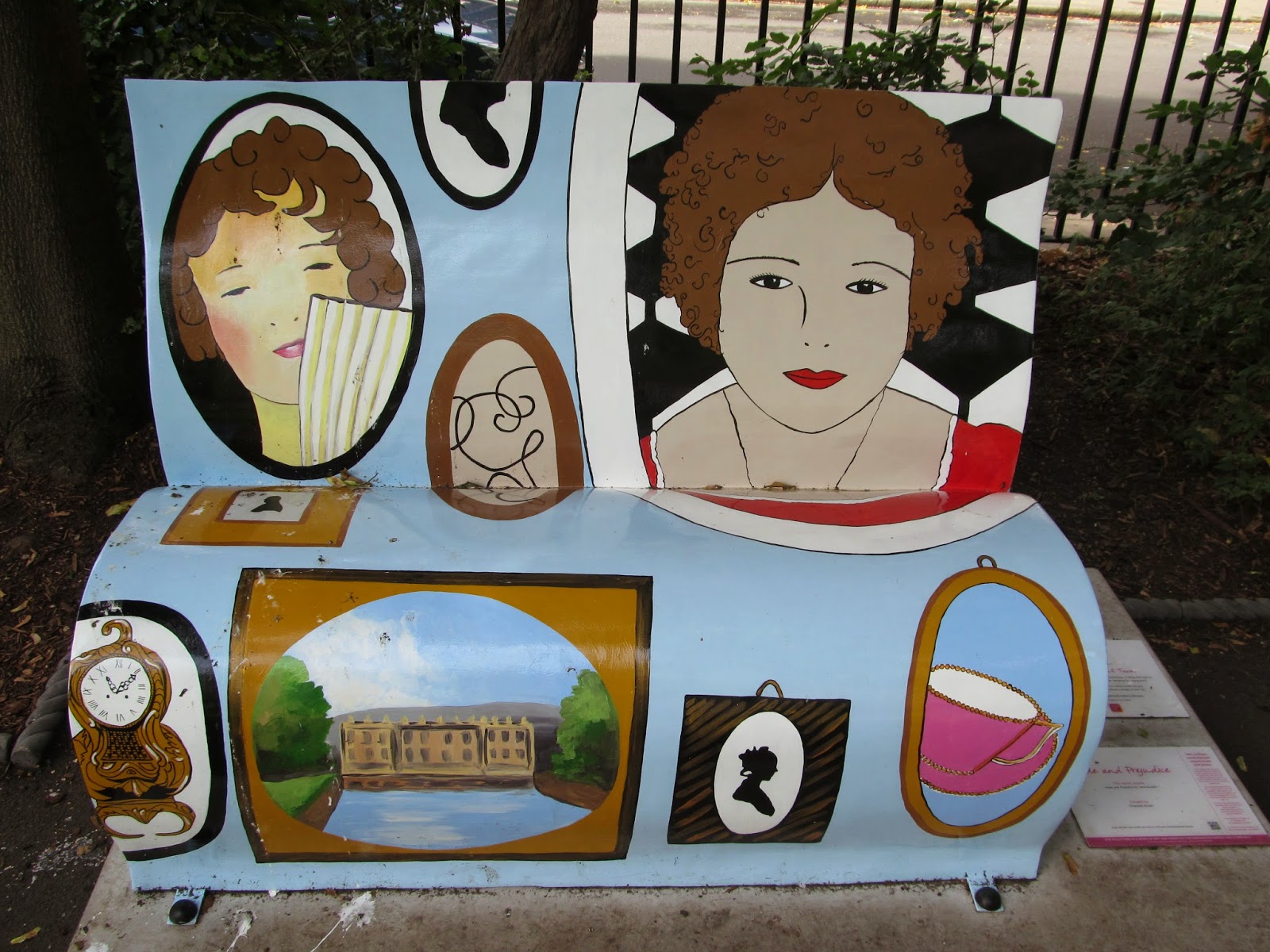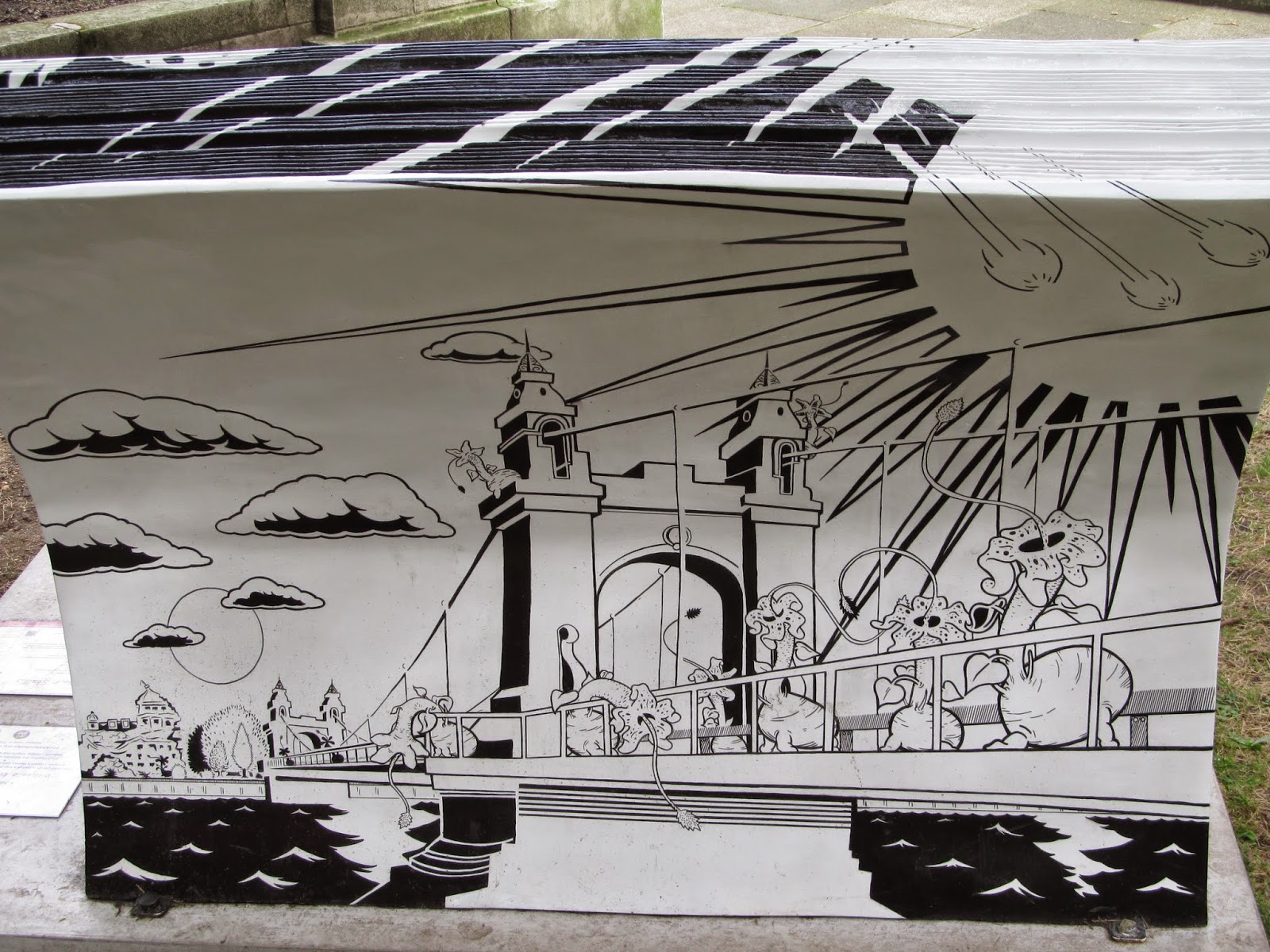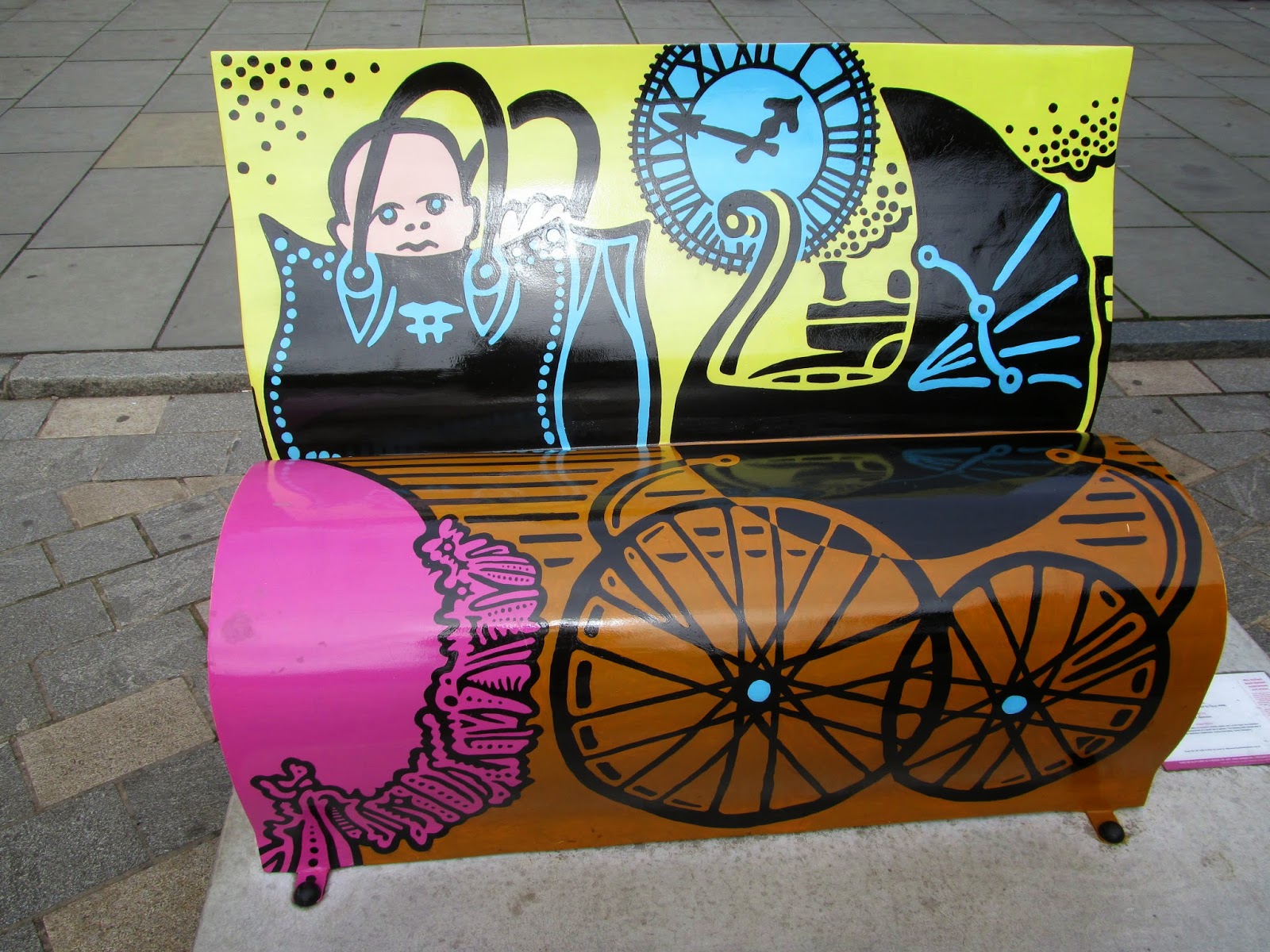Dear Reader, I have held you in abeyance for too long. Now, I must recount my hunt for the remaining benches during August and September last year.
On the 8th August 2014, I hit the London Bridge and Southbank area to find as many of the benches as I could.
Great Expectations (Bench 24 - 8th August 2014)
The front of the bench depicting gaslight lit streets and towards the bottom half of the bench doomed to be sat on is the convict, Magwitch. The bench was located not far from Borough Market.
The back of the bench illustrates a riverside scene.
Please Look After This Bear. Thank You. (Bench 25 - 8th August 2014)
Poor Paddington Bear on his own with his beloved marmalade at Paddington Station. This is the front of the bench that was located next to the Great Expectations bench. I was surprised how often the benches could be found in close proximity to each other.
The back of the bench is actually quite sad. The lone Paddington Bear sits alone sharing his food with the pigeons whilst he sees people in the distance. How many people are honest enough to admitting to having days when they have felt this alone?
From The Gruffalo to Scarecrows: The World of Axel Scheffler and Julia Donaldson (Bench 26 - 8th August 2014)
The front of the bench which was located near to London City Hall. The only one of the benches, which had a fence around it. The bench includes characters from the worlds created by Axel Scheffler and Julia Donaldson.
The back of the bench featuring such delightful elements as a loving Scarecrow couple, a goat and a pig.
The Librarian - Discworld (Bench 27 - 8th August 2014)
The front of the bench depicting a character from Terry Prachett's 'Discworld' novels. It was located in More London (the area near the City Hall).
The back of the bench revealing the Discworld in all its glory.
Clarice Bean (Bench 28 - 8th August 2014)
This was quite a popular bench in the More London area again (as you can see from the legs behind it). Clarice's comment is very true though, there are times when you want to start again upon finishing a good book.
The back of the bench with another of Clarice Bean's wise sayings. I didn't know her beforehand but now I feel like an acolyte, sharing her sayings with the world.
How to Train Your Dragon (Bench 29 - 8th August 2014)
The front of the bench located in More London depicted a big blue dragon and the wild sea.
The back of the bench upon which a red dragon can be seen flying.
The World Of Dr. Seuss (Bench 30 - 8th August 2014)
This bench was located in More London. I really liked how vibrant and colourful the bench was. All of Dr. Seuss' most well known characters are depicted including The Cat in the Hat.
The back of the bench contains images of the book covers. Definitely, one of my favourites of the benches.
Through The Looking Glass (Bench 31 - 8th August 2014)
This bench was also located in More London and was an absolute nightmare to photograph. A woman had made herself very comfortable on this bench and I had to politely ask her to move, so that I could take a quick photograph and she gave me a filthy look before moving. I felt a bit rotten because the moment she shifted everyone ran to take photos of the bench. The utter surrealism of the novels is captured magnificently by the artist. The bizarre chess board image mirrors a scene in one of the novels if I am not mistaken.
The back of the bench was slightly less interesting, although not easy to photograph.
Remember how I couldn't find three of the Greenwich Park benches? Well, on my Mum's birthday, my Mum, sister and I went traipsing around the park in hunt of the little darlings. My sister's sense of direction being far more useful than my own.
Elmer The Patchwork Elephant (Bench 32 - 23rd August 2014)
The front of the bench was covered with multiple images of linked elephants. The only one that is different can be seen at the bottom right of the bench as it is black and white. I suspect that this bench is a celebration of individuality as this tends to be the message perpetuated by many children's books.
The back of the bench is a patchwork of coloured squares.
The Time Machine (Bench 33 - 23rd August 2014)
The front of the bench, which was located near to the Royal Observatory in Greenwich Park. Another bench, which required my Mum this time to politely ask the guardians of the bench to shift, so that about eight separate people could take photos of it. Marvel at the detail of the time machine and remember how much you enjoyed reading the H.G. Wells' novel.
The back of the bench featuring all of the sophisticated equipment that you would need to travel through time. Remember the novel was written prior to the days of the ZX 81!
We're Going On A Bear Hunt (Bench 34 - 23rd August 2015)
The front of the bench located near to a pond in Greenwich Park, which was clearly intended owing to the image on here of a bunch of kids looking down into a pond.
The back of the bench featuring a large hill and a dog in the grass at the bottom right. This bench also required some tactful negotiation with the occupiers, so that the bench could be photographed.
The next leg of the bench hunt took me over to the Bloomsbury area of London and around that neck of the woods on the 30th August 2015.
James Bond (Bench 35 - 30th August 2014)
This bench was located in Bloomsbury Square Gardens. The artist has cleverly incorporated details form the James Bond novels such as the man himself drinking Martini and references to gambling.
The back of the bench plays on the voodoo elements that feature in some of the Bond novels such as 'Live and Let Die'.
The Agatha Christie BookBench. Also known as Hercule Poirot and the Greenshore Folly (Bench 36 - 30th August 2014)
This bench was located in Bloomsbury Square Gardens and incorporates elements from the novella 'Hercule Poirot and the Greenshore Folly', which was later expanded to become 'Dead Man's Folly'. Agatha Christie filled both stories with aspects of her own life and the region where she lived.
The back of the bench and a very striking female face. I love the use of flowers and butterflies on this bench. This is another of my favourite benches.
"Always try to be a little kinder than is necessary" - Peter Pan (Bench 37 - 30th August 2014)
This bench was located in Red Lion Square Gardens and was the second of the Book Benches to be based upon 'Peter Pan'. I hope that I regularly try to live by the above proverb. Kindness is important. Lots of elements from 'Peter Pan' appear on this bench.
The back of the bench featuring Captain Hook's ship and various underwater elements including a particularly fetching mermaid.
Pride and Prejudice (Bench 38 - 30th August 2014)
This bench was located in Queen Square Park and Garden. The front of the bench reveals lots of elements from Jane Austin's novels. Alternatively, it can be seen as a series of cliches surrounding the upper classes depending upon whether you like Jane Austin.
The back of the bench again containing elements from the novel. A slightly awkward photo on account of the bench's position, which I believe may have been next to a fence. This was one of the recurring problems with taking photos of some of the benches (they were too close to walls or fences).
Rest Your Stalks - The Day of the Triffids (Bench 39 - 30th August 2014)
The front of the bench which was located near to Senate House featuring the ever lovely Triffids and the literally blinding celestial bodies that helped to make the stupid human race their victims.
The back of the bench illustrating the Triffids and their gradual incursion into London. A very lovely tribute to the brilliant novel, 'The Day of the Triffids' by John Wyndham.
Earnest (Bench 40 - 30th August 2014)
This very stylish and colourful bench was located in Byng Place. Again, elements from the work that the bench was based on appear on this bench. The front of the bench features prominent plot elements from Oscar Wilde's play, 'The Importance of Being Earnest', particularly note the child in the handbag.
The back of the bench which I believe plays on the concept of assuming various identities, in order to achieve your goals. I love the striking and bold nature of this image.
The Curious Case of Sherlock Holmes (Bench 41 - 30th August 2014)
The front of the bench located in Woburn Square Garden. There were works being completed the day I visited the bench. This explains the odd angle. Lots of Sherlock Holmes' references for you all to deduce. Not least, the violin!
The back of the bench seemingly picking up on keywords associated with Sherlock Holmes centred within the spines of other Sherlock Holmes' stories.
Mrs. Dalloway (Bench 42 - 30th August 2014)
The front of the bench rather austerely and delicately revealing the loves and fascinations of Mrs. Dalloway, Virginia Woolf's eponymous heroine. I like the clock face in the background. Time waits for no-one.
The back of the bench which was located in Gordon Square Gardens. For those in the know, the Woolfs lived in a property on Gordon Square from 1904 to 1907. I initially did not think much of this bench. It seemed too dark but it has grown on me.
1984 (Bench 43 - 30th August 2014)
The front of the bench which is quite simply stunning yet also too busy unless you are standing next to it. 'Nineteen Eighty-Four' is perfectly rendered. It was located opposite Senate House between Malet Street and Torrington Square.
The back of the bench which is just as busy. Something about the style reminds me of Russian Expressionism and Cubism. This was one of my favourite benches. The automation and brutal order of day to day life perfectly shines through this bench.
Jeeves and Wooster (Bench 44 - 30th August 2014 (Back of bench) and 7th September 2014 (Front of bench))
The back of this bench based on P.G. Wodehouse's 'Jeeves and Wooster' stories. The bench was located in the Brunswick Centre and needless to say, being a bench in a shopping centre around lunchtime, the possibility of getting a shot of both sides of the bench was pretty unlikely. I managed to capture the back of the bench on 30th August 2014. I did hang around the general area for a little while trying to capture the front of the bench but sadly, no luck on this occasion. Jeeves serves his employer drinks, whilst he engages in a game of Croquet.
The front of the bench implying that someone can't handle his drink! This photograph was taken on 7th September 2014.
The Lion, The Witch and The Wardrobe (Bench 45 - 30th August 2014)
The front of the bench depicting an event in C.S. Lewis' 'The Lion, The Witch and The Wardrobe'. Narnia in all its cold beauty.
The back of the bench with a stunning representation of Aslan the Lion. The bench was located in St George's Gardens.
The World's Biggest Flipbook (Bench 46 - 30th August 2014)
The front of the bench finally photographed on the 30th August 2014. This bench was located underneath an escalator in Waterloo Station. Another nightmarish bench to photograph. People do like to sit! The characters on the bench are the products of the imagination of Jeremy Banks, a cartoonist.
The back of the bench with some particularly charged graffiti including 'improved literacy'. This bench is all about encouraging reading, as a means of progressing out of the sludge of everyday existence. Notice all of the cartoon images of rubbish and the pigeons feeding on the waste of our consumer culture.
War Horse (Bench 47 - 31st August 2014)
The front of the bench containing elements from 'War Horse'. The poppies are a particularly touching feature of the bench, which was located in More London Place (off of Tooley Street).
The back of the bench featuring the aftermath of war.
Around The World In Eighty Days (Bench 48 - 31st August 2014)
One of the very hidden benches. This was located in Stanfords, the Travel bookshop in Long Acre. Rather incongruously, it includes the London Eye, which wasn't featured in Jules Verne's classic. Although, it's nice to see how the methods of transport used by Fogg and his companion are used on this bench. See if you can spot the elephant.
The back of the bench effectively giving the plot of the novel in the style of a newspaper article.
Neverwhere (Bench 49 - 7th September 2014)
This bench was the very secret bench. It was the last one added. It was located in the Guardian Towers, next door to King's Place. Unfortunately, when I visited the bench was right against the wall, so you could not see the back illustration. As such, you can only see the front of the bench featuring characters from 'Neverwhere' by Neil Gaiman in my photograph. You can see the back of the bench on various websites
including http://www.theguardian.com/books/booksblog/gallery/2014/sep/12/neverwhere-book-bench-come-see-it-at-the-guardian.
Katie in London (Bench 50 - 7th September 2014)
The back of the bench located near to the Tower of London. Although, this bench had a lot of activity. It's interesting that people were content just to sit quickly then move on. This of course was not the case with some of the other benches. It's intriguing how some areas feel more conducive to sitting than others. Anyhow, elements from 'Katie in London' by James Mayhew.
The front of the bench containing lots of London landmarks etc and an excited couple of kids riding a lion with a Union Flag.
Noughts and Crosses (Bench 51 - 7th September 2014)
The front of the bench depicting elements from a series of books by Malorie Blackman set in a dystopian future. The Noughts and Crosses being two disparate groups.
The back of the bench which was located in Fen Court. Love in the shadows of chaos. This was the last bench I photographed and I felt a certain sense of sadness as I walked away aware that I had finally accomplished what I had set out to do.
Afterword.
The benches and the characters, environments and ideas they represent are copyright to their respective artists and also to the authors upon whose works, most of the benches are based,
For more information on the auction that took place once the benches were removed and the prices that they gained at auction at the Southbank Centre on 7th October 2014, please see the following link:
http://www.booksabouttown.org.uk/?action=ViewPage&Id=9
The Guardian website link is of course, copyright to The Guardian.
Barry Watt - 15th February 2015.






















































